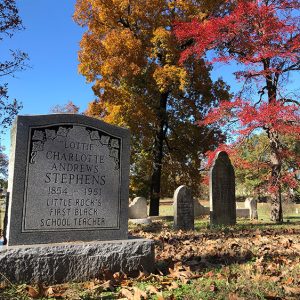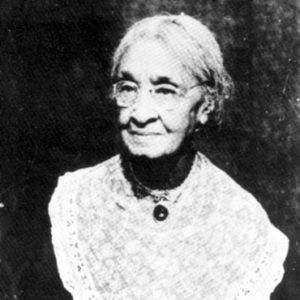calsfoundation@cals.org
Charlotte Andrews (Lottie) Stephens (1854–1951)
Charlotte Andrews Stephens was the first African American teacher in the Little Rock (Pulaski County) school district. She worked as a teacher for seventy years, and Stephens Elementary School in Little Rock was named for her in 1910. In addition, she was the first African American to be accredited by the North Central Association and was a charter member of the National Association of Colored Women (NACW) federated club in Little Rock.
Lottie Andrews was born in 1854 in Little Rock to William Wallace Andrews, a “mulatto” slave to U.S. Senator Chester Ashley, and Caroline Williams Andrews, a slave to the Noah Badgett family. The system of urban slavery in Arkansas allowed the Andrews family special privileges. Andrews’s parents were both educated by their masters, and the Ashley family provided her family a home at Tenth and Broadway. In 1854, the Ashleys gave land at 8th and Broadway for a church that Andrews’s father headed. This Methodist Episcopal congregation took the name of Wesley Chapel, and Andrews’s father served there as minister and teacher while working as a carpenter and cabinetmaker. Her mother was allowed to “hire out” her services as a laundress and was thus able to live in the city with her husband rather than work away from Little Rock with the Badgett family. This practice was outlawed by the city of Little Rock in 1856, as Arkansas laws became harsher for African Americans with the approach of the Civil War. Andrews had one brother who died as a youth one year after her father’s death in 1866.
Andrews’s childhood was influenced by her father’s religion and his goal of educating his children and parishioners. In 1863, halfway through the Civil War, Little Rock was occupied by Union forces. Their presence brought freedom to slaves within the city and in other parts of Arkansas. To serve this new community of freedmen, Andrews’s father opened a private school in the church. Within months, he turned over his school to the visiting American Missionary Association. By 1867, the Society of Friends (Quakers), under the auspices of the Freedmen’s Bureau, erected a school at 6th and State called Union School. In 1869, at the age of fifteen, Andrews began her teaching career, substituting for her own teacher, who had fallen ill near the end of the school year. In the same period, the city of Little Rock organized its own public school system and bought the Quakers’ property. At the end of that school term, Stephens and three other black teachers were hired for the following year, making her the first black teacher in the system by virtue of having taught part of the preceding term. After teaching one full year, Stephens took her savings and a leave of absence to attend Oberlin College in Ohio. She attended a total of three years, intermittently returning to Little Rock to teach and earn money to pay for her schooling.
At Oberlin, she lived in Ladies Hall with white females and only a handful of black students. She recalled that Oberlin was like heaven to her as she studied Latin, geometry, the history of Rome, music, English, and the Bible. In 1873, she returned to Little Rock to teach steadily, updating her credentials through courses at teachers colleges and institutes, though she never received a degree.
She married John Herbert Stephens, with whom she had eight children, with six living to adulthood. Stephens’s husband was both a cabinetmaker and teacher and served in public life as a deputy sheriff and deputy constable in the period Stephens described as “that time that Negroes served in public office.” Her reference was to that historical window immediately following the Civil War when black residents could vote and participate in civic affairs. But by the 1890s, Arkansas’s legalized segregation and disfranchisement (especially through the Election Law of 1891 and a poll tax) removed most of the state’s black population from the political process.
Stephens worked as a teacher in Little Rock for seventy consecutive years before her retirement in 1939. Her career included thirty years as an elementary school teacher, thirty as a high school teacher, and ten as a teaching librarian in a high school and junior college. In 1910, Stephens Elementary School, currently located at 3700 West 18th Street, was named for her. It remained the only school in Little Rock for the next fifty years named for a woman. In 1950, a modern building replaced the original; a third structure opened in January 2001 and continues to honor her name. At a public ceremony in 1950, the all-white Little Rock School Board honored Stephens for her teaching career.
Stephens died on December 17, 1951. Her funeral was held at Wesley Chapel Methodist Church, the same church founded by her father, and she is buried at Oakland Cemetery in Little Rock.
For additional information:
Gordon, Fon Louise. “Black Women in Arkansas.” Pulaski County Historical Review 35 (Summer 1987): 26–28.
Kennan, Clara B. “The First Black Teacher in Little Rock.” Arkansas Historical Quarterly 9 (Autumn 1950): 194–204.
Terry, Adolphine Fletcher. Charlotte Stephens: Little Rock’s First Black Teacher. Little Rock: Academic Press of Arkansas, 1973.
Sondra Gordy
University of Central Arkansas
This entry, originally published in Arkansas Biography: A Collection of Notable Lives, appears in the CALS Encyclopedia of Arkansas in an altered form. Arkansas Biography is available from the University of Arkansas Press.
 Education, Elementary and Secondary
Education, Elementary and Secondary Post-Reconstruction through the Gilded Age, 1875 through 1900
Post-Reconstruction through the Gilded Age, 1875 through 1900 Charlotte Stephens Grave
Charlotte Stephens Grave  Charlotte Stephens
Charlotte Stephens 




What an amazing woman. We need to teach her story to every student in the state. Her life spanned the Civil War to segregation, horse and buggy to automobile. I will be reading more of the sources listed.